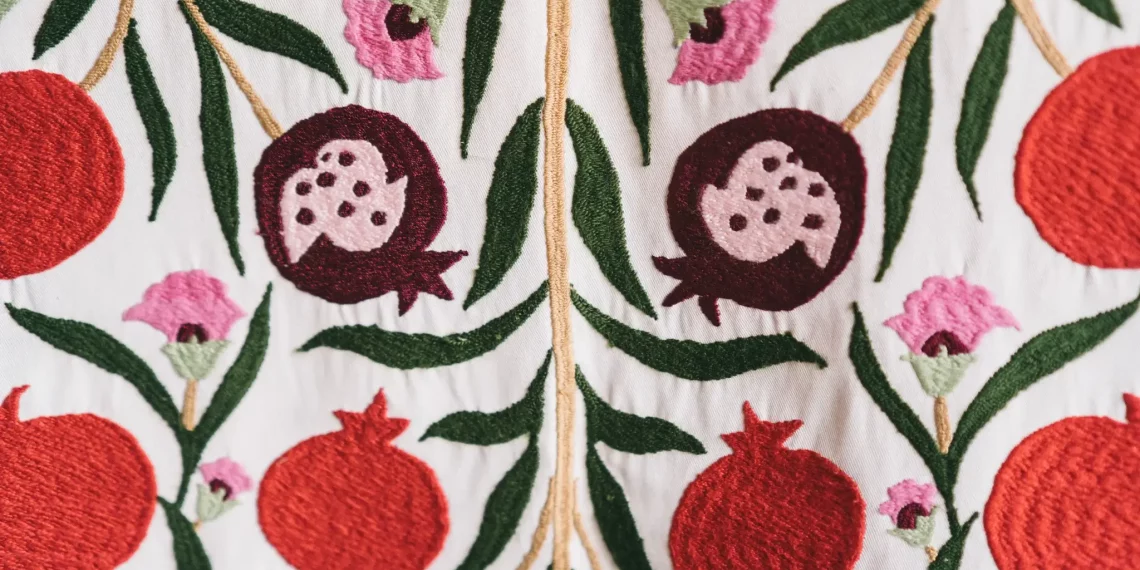Welcome! Step into the world of Suzani, a realm of awe-inspiring colors and designs. Curious about the story these threads tell? Come, let’s unveil the artistry behind handmade Suzani embroidery.
Table of Contents
Introduction to Suzani Embroidery
Ever noticed the vibrant, intricately designed, eye-catching textiles adorned with stunning patterns? That’s Suzani for you! Originating from Central Asia, Suzani, meaning “needlework”, is a form of embroidery that’s not just a craft but a testament to a rich cultural tapestry.
History of Suzani Embroidery
Early Origins
Rewind the clock to the 18th century. Here, we see the inception of Suzani in the heart of Central Asia, where young girls would weave dreams and hopes into textiles as part of their dowries. Isn’t it fascinating how threads can tell a tale of time?
Cultural Influence
You may ask, what makes Suzani unique? It’s the incorporation of cultural narratives and symbolism. Each stitch resonates with the rhythmic tunes of Central Asian life, adding a soulful depth to the designs.
The Art of Creating Suzani
Preparation of Materials
Ready to delve into the making of Suzani? It starts with preparing the fabric, usually cotton, silk, or velvet. The design is then sketched out, waiting to be brought to life by skilled artisans.
Types of Stitches
Chain Stitch
The chain stitch, forming a chain-like pattern, is the most common in Suzani, providing both versatility and durability. It’s like weaving a story, one link at a time.
Satin Stitch
Satin stitch, on the other hand, is used to fill larger areas with a glossy finish, akin to painting with threads!
Buttonhole Stitch
The buttonhole stitch is often employed to add an extra layer of detail and complexity to the designs. Doesn’t it remind you of the icing on a cake?
Iconography in Suzani Embroidery
Flowers and Vines
In Suzani, nature takes a central role. Flowers and vines, symbolizing fertility and vitality, are common motifs. Don’t they bring a sense of vibrancy and life to the textiles?
Sun and Moon
Celestial symbols like the sun and moon, signifying life cycles and the universe, are frequently seen. Isn’t it awe-inspiring to see such profound motifs skillfully stitched into the fabric?
Birds and Animals
The enchanting world of Suzani isn’t complete without birds and animals, symbolizing prosperity and protection. Can you feel their energy resonating through the patterns?
Modern Adaptations of Suzani
Tradition meets modernity in the contemporary interpretations of Suzani. These adaptations retain the core essence while incorporating novel elements, infusing a breath of fresh air into the age-old artistry. Exciting, isn’t it?
The Global Influence of Suzani
In Fashion
Have you seen the haute couture runways adorned with Suzani-inspired designs? From dresses to accessories, the fashion world has embraced Suzani, making it a global trendsetter.
In Home Decor
Your living room could use a Suzani touch too! Suzani embroidered cushions, wall hangings, or rugs can turn a space into a cozy and vibrant nook, showcasing the magic of handcrafted artistry.
Care and Maintenance of Suzani
As with any piece of art, Suzani needs love and care. Gentle cleaning, avoiding direct sunlight, and periodic airing can ensure the longevity of your precious Suzani pieces. Easy enough, right?
The Timeless Allure of Suzani
From Central Asia to global ramps and living rooms, Suzani embroidery continues to enchant with its vibrant colors, intricate designs, and profound symbolism. It’s not just a craft, but a woven chronicle of culture and history. The story of Suzani truly is a journey, don’t you think?
FAQs
What does Suzani mean? Suzani, derived from the Persian word ‘Suzan’, means needlework.
Where did Suzani originate? Suzani originated in Central Asia, specifically in regions of present-day Uzbekistan and Tajikistan.
What materials are used in Suzani embroidery? Commonly used materials include cotton, silk, or velvet for the base fabric, and silk or cotton threads for the embroidery.
What are the common motifs in Suzani designs? Flowers, vines, sun, moon, birds, and animals are common motifs in Suzani designs, each carrying symbolic meanings.
How can I care for my Suzani textiles? Suzani textiles require gentle cleaning, protection from direct sunlight, and regular airing to ensure longevity.

